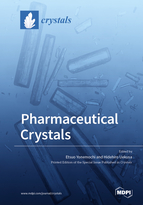Pharmaceutical Crystals
A special issue of Crystals (ISSN 2073-4352). This special issue belongs to the section "Crystal Engineering".
Deadline for manuscript submissions: closed (30 September 2019) | Viewed by 44127
Special Issue Editors
Interests: physicochemimcal properties; physical property analysis; crystal form; polymorph prediction
Special Issues, Collections and Topics in MDPI journals
Interests: crystallography; structure analysis; pharmaceutical crystals; phase transition
Special Issues, Collections and Topics in MDPI journals
Special Issue Information
Dear Colleagues,
We are delighted to invite you to submit an article to the “Pharmaceutical Crystals” Special Issue of Crystals.
Needless to say, the crystalline state is the most used and the most important form of solid active pharmaceutical ingredients (APIs). The characterization of pharmaceutical crystals encompasses numerous scientific disciplines, and its center is crystal structure analysis, which reveals the molecular structure of important pharmaceutical compounds, and also affords key structural information that relates to the broadly variable physicochemical properties of the APIs, e.g., solubility, stability, tablet ability, color, and hygroscopicity.
The Special Issue on “Pharmaceutical Crystals” aims to publish novel molecular and crystal structures of pharmaceutical compounds. We especially encourage the submission of works of new crystal structures of APIs including polymorphs and solvate crystals, and of multi-component crystals of APIs including co-crystals and salts, which would be related to changes of the physicochemical properties of pharmaceutical crystals.
This Special Issue demonstrates the importance of crystal structure information in many sectors of pharmaceutical science and engineering, and thus contributions from both industry and academia are welcome.
Prof. Etsuo Yonemochi
Prof. Hidehiro Uekusa
Guest Editors
Manuscript Submission Information
Manuscripts should be submitted online at www.mdpi.com by registering and logging in to this website. Once you are registered, click here to go to the submission form. Manuscripts can be submitted until the deadline. All submissions that pass pre-check are peer-reviewed. Accepted papers will be published continuously in the journal (as soon as accepted) and will be listed together on the special issue website. Research articles, review articles as well as short communications are invited. For planned papers, a title and short abstract (about 100 words) can be sent to the Editorial Office for announcement on this website.
Submitted manuscripts should not have been published previously, nor be under consideration for publication elsewhere (except conference proceedings papers). All manuscripts are thoroughly refereed through a single-blind peer-review process. A guide for authors and other relevant information for submission of manuscripts is available on the Instructions for Authors page. Crystals is an international peer-reviewed open access monthly journal published by MDPI.
Please visit the Instructions for Authors page before submitting a manuscript. The Article Processing Charge (APC) for publication in this open access journal is 2600 CHF (Swiss Francs). Submitted papers should be well formatted and use good English. Authors may use MDPI's English editing service prior to publication or during author revisions.
Keywords
- Pharmaceutical crystals
- Co-crystals
- Salts
- Solvates
- Physicochemical properties
- Crystal engineering
Related Special Issues
- Pharmaceutical Crystals (Volume II) in Crystals (10 articles)
- Pharmaceutical Crystals (Volume III) in Crystals (4 articles)







